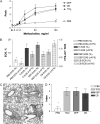Pulmonary exposure to particles during pregnancy causes increased neonatal asthma susceptibility
- PMID: 17656681
- PMCID: PMC2176127
- DOI: 10.1165/rcmb.2007-0124OC
Pulmonary exposure to particles during pregnancy causes increased neonatal asthma susceptibility
Abstract
Maternal immune responses can promote allergy development in offspring, as shown in a model of increased susceptibility to asthma in babies of ovalbumin (OVA)-sensitized and -challenged mother mice. We investigated whether inflammatory responses to air pollution particles (diesel exhaust particles, DEP) or control "inert" titanium dioxide (TiO(2)) particles are enhanced during pregnancy and whether exposure to particles can cause increased neonatal susceptibility to asthma. Pregnant BALB/c mice (or nonpregnant controls) received particle suspensions intranasally at Day 14 of pregnancy. Lung inflammatory responses were evaluated 48 hours after exposure. Offspring of particle- or buffer-treated mothers were sensitized and aerosolized with OVA, followed by assays of airway hyperresponsiveness (AHR) and allergic inflammation (AI). Nonpregnant females had the expected minimal response to "inert" TiO(2). In contrast, pregnant mice showed robust and persistent acute inflammation after both TiO(2) and DEP. Genomic profiling identified genes differentially expressed in pregnant lungs exposed to TiO(2). Neonates of mothers exposed to TiO(2) (and DEP, but not PBS) developed AHR and AI, indicating that pregnancy exposure to both "inert" TiO(2) and DEP caused increased asthma susceptibility in offspring. We conclude that (1) pregnancy enhances lung inflammatory responses to otherwise relatively innocuous inert particles; and (2) exposures of nonallergic pregnant females to inert or toxic environmental air particles can cause increased allergic susceptibility in offspring.
Figures





References
-
- von Mutius E, Schmid S, the PASTURE Study Group. The PASTURE project: EU support for the improvement of knowledge about risk factors and preventive factors for atopy in Europe. Allergy 2006;61:407–413. - PubMed
-
- Wills-Karp M. Murine models of asthma in understanding immune dysregulation in human asthma. Immunopharmacology 2000;48:263–268. - PubMed
-
- Weiss ST. Epidemiology and heterogeneity of asthma. Annals of Allergy, Asthma, &. Immunology 2001;87:5–8. - PubMed
-
- Martinez FD, Wright AL, Taussig LM, Holberg CJ, Halonen M, Morgan WJ. Asthma and wheezing in the first six years of life. The Group Health Medical Associates. N Engl J Med 1995;332:133–138. (see comments). - PubMed
Publication types
MeSH terms
Substances
Grants and funding
LinkOut - more resources
Full Text Sources
Medical
Molecular Biology Databases

